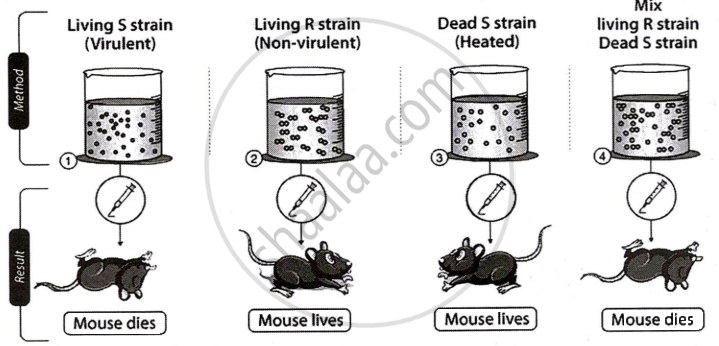Advertisements
Advertisements
Question
Griffith conducted a series of experiments on mice with two different strains of the bacterium Diplococcus pneumoniae.
- Describe the entire procedure for this experiment.
- Write the conclusion of this experiment.
- What would have been the result of the experiment if both strains of bacteria were first heat-killed, mixed and then injected in the mice?
Solution
- During the experiment, Griffith cultivated Diplococcus pneumonial bacteria, which exhibited two growth patterns. One culture plate contained smooth, glossy colonies (S), whereas the other contained rough colonies (R). The difference was attributable to the presence of a mucous coat in S strain bacteria, whereas R strain bacteria lacked one.
Griffith introduced both S and R strains into mice. The person infected with the S strain died from pneumonia, whereas the one infected with the R strain survived.
In the second stage, Griffith heat-killed the S strain bacteria and injected them into mice, but the mice survived. Then he combined the heat-killed S and live R strains. This concoction was put into mice, which died. In addition, he discovered live S-strain bacteria in deceased mice.
- Griffith inferred from his observations that S strain bacteria had altered R strain bacteria. The R strain inherited a 'transforming principle' from the heat-killed S strain bacteria, which made them virulent and he adopted this transforming principle as genetic material.
- If both strains of the bacteria were first heat-killed, mixed, and then injected into mice, the mice would stay alive because heat-killing bacteria would destroy their ability to cause infection.
APPEARS IN
RELATED QUESTIONS
Mention one significant difference between Phenotype and Genotype
Describe the experiment performed by Griffith. What conclusions did he infer from his observations?
(a) Why did Hershey and Chase use radioactive 32P and 35S in their experiments? Explain.
(b) Following the experiments conducted by them, write what conclusion did they arrive at and how ?
Hershey and Chase experiment with bacteriophage showed that ____________.
The two strands of DNA are held together by ______.
In Streptococcus pneumoniae ______.
The process of transformation is not affected by which of the following enzymes?
- DNase
- RNase
- Peptidase
- Lipase
Which one among the following was the first genetic material?
Identify the compound chemical structure is shown below. State any three of its physical properties.

Name the scientist who proved experimentally that DNA is the genetic material ______.
